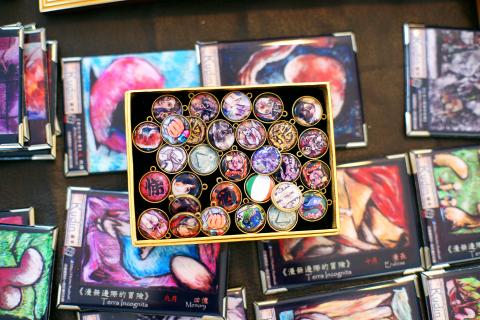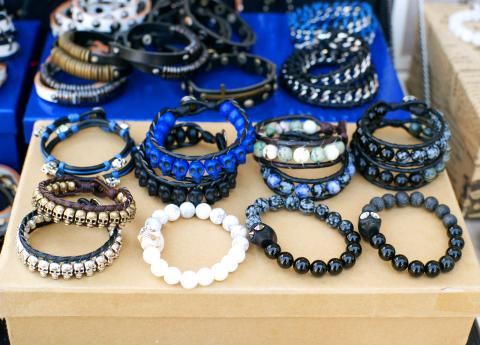Charles McDonald was certain he had the perfect business strategy all worked out. Proud of his heritage (his mother is Taiwanese), the plan involved designing T-shirts that would blend elements of Taiwan’s unique culture, and pitch them to customers at Taipei’s weekend markets in the parlance of Taiwanese identity and the injustice of the nation’s international isolation. He soon learned, however, that people weren’t interested.
“At first I was too idealistic. But you can’t be like this when doing business,” says McDonald, 27, a US native who came to Taiwan in 2009 to learn Mandarin and take a break from his job as an accountant. “Consumers want something that is fun and positive, not stressful.”
So like any astute entrepreneur, he responded to customer dislikes and toned down the political rhetoric, while retaining the likes: minimalist designs that riff off of Taiwan’s traditional culture and modern urban vibe. Today, the clothing he sells under his name brand IDCY earns him a steady income.

Photo: Noah Buchan, Taipei Times
“Working at weekend markets has taught me to know what sells and what doesn’t,” he says.
McDonald, 27, is one of hundreds of independent designers who ply their trade at Taipei’s weekend creative markets. He’s set up booths at the flea market in Tianmu (天母), which sells handicrafts and second-hand goods, the Simple Market (簡單市集) at the Xinyi Public Assembly Hall (信義公民會館) and Shida’s (師大) weekend market. But McDonald consistently returns to the weekend market at Ximen’s Red House (西門紅樓) due to the demographic of shoppers it attracts and the organizational structure of its management, which nurtures vendors until they have enough revenue and products to strike out on their own and fulfill their dream of opening their own store.
Launched as a two-month project by the Taipei City Government in 2007, the market was such a hit with locals and tourists that it was made permanent in 2008, when Red House took over its management. Unlike most weekend markets, Red House focuses only on handicrafts. No food, no beverages. Additionally, vendors have to demonstrate that their products are locally designed and made before they are given a booth.

Photo: Noah Buchan, Taipei Times
And if visitor numbers and vendor satisfaction are anything to go by, it’s been a success. Last year the market, open Saturdays and Sundays from 2pm to 10pm and located under several white tents in a square beside the historic building, attracted over 4 million people, says Maggie Fan (范瓊方), the manager of Red House.
“Five years ago, the area out front of Exit 1 [of the Ximending MRT Station] was deserted on weekends,” says Fan, referring to the exit across from the market. “Now it’s always crowded.”
From typical creative market items such as E&A Life Design’s t-shirts, which are emblazoned with fauna native to Taiwan, to the cool kitsch of Glam Rock’s bracelets made with tiny plastic skulls to JoS Design’s (簪簪自囍) Chinese-style hairpins intricately carved from fragrant sandalwood, there is something here for anyone looking to buy a gift for themselves or someone else.

Photo: Noah Buchan, Taipei Times
And, unusually for Ximending, the crowds aren’t made up of teenyboppers and the elderly. Groups of 30-somethings wander through the crowded space with families. It’s common to see Western tourists and hear Japanese being spoken.
Fan says visitors like the market because the products are of high quality and it replicates the congested vibe of Taiwan’s many night markets. Just don’t expect that bartering will reduce the price, she says.
A woman from Japan attempted to haggle down the price of one of Grion’s reusable waterproof shopping bags, and became incensed when the vendor refused to budge.
“Come on, it’s a market isn’t it?” she grumbled to the vendor in English.
A few kiosks down, Ian Chang (張書晏) of Tradivance (前傳), a portmanteau of tradition and advance, says he used to barter with customer, but doesn’t anymore.
“My products are already inexpensive and of good quality,” says Chang.
Chang, echoing a sentiment of the dozen or so vendors I spoke with, says he is attracted to the market because it’s well organized and stable. And with space costing NT$1,200 for both days, it’s an affordable testing ground for his products.
Chang says he earned NT$5,000 over the weekend when he first started selling his custom-made leather handbags, wallets and key chains at the market a year ago. Today he usually earns triple that amount, mainly by selling his most popular item: leather smartphone covers.
But the market isn’t just about making a buck. Fan says Red House’s primary goal is to provide a platform where fledgling handicraft businesses can grow at their own pace. There are, however, restrictions.
Before they set up a booth, vendors must first present Red House with a business plan, which includes a brand name, line of products, online information (blog, Facebook, Web site) and a clear set of goals. Once their portfolio is accepted, the management offers courses on how to market their products and opportunities to participate in overseas exhibitions. They also help vendors arrange press conferences when launching new products.
“It’s an ideal testing ground to get their brand going,” says Fan. Strict application rules, Fan says, ensures that vendors are serious and professional about the products they make and sell.
After vendors demonstrate a consistent level of profitability, they are encouraged to apply for one of 22 studio spaces located inside Red House. Open Sundays to Thursdays from 2pm to 9:30pm and Saturdays and Sundays from 2pm to 10pm, the venue provides a permanent space for vendors to take that next step.
But it’s not an easy transition. Chang Li-chin (昌麗琴, who goes by Ah-qing, 阿琴), of Regine’s Make and Sell Store (自做自售) says she worked an office job during the day while spending her evenings designing bags emblazoned with symbols of Taiwan’s history and culture. Her weekends were spent at Red House.
Her hard work paid off, though, and earlier this year she moved into one of Red House’s studio spaces, where she works fulltime. And though at NT$20,000 per month her rent is significantly more expensive, Ah-qing says she’s seen her brand recognition grow and profits soar.
“I earned about NT$3,000 when I first started — but that was for a week’s work. Now, when business is good, I can earn more than NT$10,000 per day,” says Ah-qing.
Others, like Ellen Lin (林怡延) and husband Ando Meritee, who is from Estonia, have a different dream. While Meritee works fulltime as an IT professional in Neihu (內湖), Lin focuses her energy on designing and promoting her hoodies, pillows and T-shirts for her brand name E&A Life Design. They work together at Red House on weekends in the hope of opening their own shop outside Red House and eventually going global.
Meritee, a seven-year resident of Taiwan who met his wife at National Taiwan Normal University’s Mandarin Training Center, tells the Taipei Times that the time when Taiwan-produced and branded products were seen as inexpensive and shoddily made has long passed.
“That’s why I don’t like ‘Made in China’ because it’s [associated with] bad quality,” says Meritee, as customers came up to admire E&A’s cutesy designs and run their hands through the downy-soft fabric that their products are made from. “Better quality, though, also means a higher price,” he says.
Ian Chang, for his part, already has a shop in Yongkang Street (永康街) but enjoys the interaction and business of the market.
“It’s really good for promotion,” he says. He adds that the combined success of his shop and booth means that he is on the lookout for an apprentice to help him keep up with orders.
Over at IDCY, McDonald says he is content to grow his business slowly and has no plans to open his own store yet, though he hopes to expand his business in the future.
“Why would I bother with the overhead [right now],” says McDonald, “ when everything I need is right here.”

In the March 9 edition of the Taipei Times a piece by Ninon Godefroy ran with the headine “The quiet, gentle rhythm of Taiwan.” It started with the line “Taiwan is a small, humble place. There is no Eiffel Tower, no pyramids — no singular attraction that draws the world’s attention.” I laughed out loud at that. This was out of no disrespect for the author or the piece, which made some interesting analogies and good points about how both Din Tai Fung’s and Taiwan Semiconductor Manufacturing Co’s (TSMC, 台積電) meticulous attention to detail and quality are not quite up to

April 21 to April 27 Hsieh Er’s (謝娥) political fortunes were rising fast after she got out of jail and joined the Chinese Nationalist Party (KMT) in December 1945. Not only did she hold key positions in various committees, she was elected the only woman on the Taipei City Council and headed to Nanjing in 1946 as the sole Taiwanese female representative to the National Constituent Assembly. With the support of first lady Soong May-ling (宋美齡), she started the Taipei Women’s Association and Taiwan Provincial Women’s Association, where she

Chinese Nationalist Party (KMT) Chairman Eric Chu (朱立倫) hatched a bold plan to charge forward and seize the initiative when he held a protest in front of the Taipei City Prosecutors’ Office. Though risky, because illegal, its success would help tackle at least six problems facing both himself and the KMT. What he did not see coming was Taipei Mayor Chiang Wan-an (將萬安) tripping him up out of the gate. In spite of Chu being the most consequential and successful KMT chairman since the early 2010s — arguably saving the party from financial ruin and restoring its electoral viability —

It is one of the more remarkable facts of Taiwan history that it was never occupied or claimed by any of the numerous kingdoms of southern China — Han or otherwise — that lay just across the water from it. None of their brilliant ministers ever discovered that Taiwan was a “core interest” of the state whose annexation was “inevitable.” As Paul Kua notes in an excellent monograph laying out how the Portuguese gave Taiwan the name “Formosa,” the first Europeans to express an interest in occupying Taiwan were the Spanish. Tonio Andrade in his seminal work, How Taiwan Became Chinese,